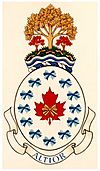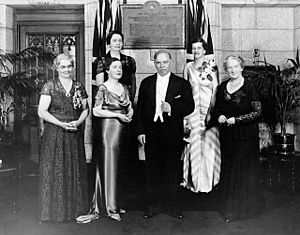National Council of Women of Canada facts for kids

The coat of arms of the NCWC
|
|
| Abbreviation | NCWC |
|---|---|
| Formation | October 27, 1893 |
| Type | NGO |
| Purpose | Social conditions |
| Headquarters | Ottawa |
| Location |
|
|
Region served
|
Canada |
|
Official language
|
English & French |
|
President
|
Patricia Leson |
|
Main organ
|
Board of directors |
| Affiliations | International Council of Women |
The National Council of Women of Canada (NCWC) is a Canadian group based in Ottawa, Ontario. Its main goal is to make life better for women, families, and communities across Canada. It is a large group made up of many smaller societies and local councils. The NCWC is also Canada's link to the International Council of Women (ICW).
Over the years, the Council has worked on many important issues. These include women's suffrage (the right to vote), immigration, health care, education, and even the environment. The NCWC was started on October 27, 1893, in Toronto, Ontario. This makes it one of the oldest groups in Canada working for social change. Lady Aberdeen was the first president of the NCWC in 1893. Other important leaders included Lady Gzowski, Dr. Augusta Stowe-Gullen, and Adelaide Hoodless.
Contents
Founding the Council
The International Council of Women was first created in 1888 in Washington, D.C., USA. By May 1893, the ICW had a big meeting in Chicago. There, they talked about starting a Canadian branch. The National Council of Women of Canada officially began on October 27, 1893. This happened at a public meeting in Toronto.
More than 1,500 women attended this important meeting. It was led by Lady Aberdeen. She was the wife of the Governor General at the time, John Campbell Hamilton-Gordon. Lady Aberdeen became the Council's first president. She served until 1899, when Lady Taylor took over.
What the Council Does
The Council gives advice on different issues. This advice is based on the group's existing policies. New ideas for policies start as resolutions. These ideas are first discussed by local groups. Then, they are debated and voted on by the larger Council. If accepted, they become official policies.
After a policy is set, the organization writes formal papers called "briefs." These briefs suggest what actions should be taken. They are then given to official bodies, like the government. The NCWC has sent representatives to government groups and international organizations. One example is the League of Nations.
The Council helped create several important Canadian organizations. These include the Victorian Order of Nurses, the Children's Aid Society, and the Consumers' Association of Canada. The Women's Art Association of Canada was also one of the first groups to join the NCWC. The Council also helped create the Women's Bureau of Labour Canada. It supported the call for the Royal Commission on the Status of Women. This commission led to the creation of the Canadian Advisory Council on the Status of Women.
Helping Women Get the Vote
From 1894 to 1918, a major goal for the Council was to improve the status of women. They worked to gain more rights for women. In 1918, the Canadian government gave women the right to vote in federal elections. This was a huge step forward.
Important Court Cases
In 1929, a group known as The Famous Five won a very important court case. It was called Edwards v. Canada (Attorney General), but it's often known as the "Persons case." This case decided that women were indeed "persons" under the law. This meant women could be appointed to the Senate. Three of The Famous Five were active members of the NCWC. The Council played a big part in winning this case.
Other Important Work
The Council has also worked on many other causes. They supported measures for child welfare, like preventing child abuse. They also encouraged better education and good health care for children. For general health, they pushed for things like pasteurization of milk and clean water. They also wanted medical checks in schools. The Council has also taken on tough issues, such as making it easier to get a divorce.
The NCWC also works with the United Nations Economic and Social Council (ECOSOC). This means they have a special role in giving advice to the UN on social and economic issues.
Famous Women in the Council

Many women in the National Council of Women of Canada have made a big difference in Canadian history. Lady Aberdeen was key in starting the Canadian branch of the Council. She had the first idea to create the organization.
Augusta Stowe-Gullen was one of the Council's co-founders. She was the first woman in Canada to earn a medical degree. She was also very important in the movement for women's right to vote. Matilda Ridout Edgar (1844–1910), later Lady Edgar, was president in 1906 and 1909. She was a skilled historian and a strong supporter of women's rights.
President Winnifred Kydd was a delegate to the League of Nations. In 1930, Cairine Wilson from the Ottawa Council became the first woman to be appointed to the Senate. All of The Famous Five—Emily Murphy, Irene Parlby, Nellie McClung, Louise McKinney, and Henrietta Edwards—were members of the NCWC. Edith Archibald also led the organization for a time in the 1880s.
See also
- Local Council of Women of Halifax
- Feminism in Canada

